
SGR passenger train on the Miritini Bridge along the Mombasa-Nairobi route. FILE PHOTO | NMG
|Business
Premium
How SGR revenues slowed before 50pc train fare raise
Growth in revenue from passenger services on the standard gauge railway (SGR) slowed down substantially before the Kenya Railways Corporation decided to raise fares by half this year, fresh data shows.
This came amidst mounting pressure for Kenya Railways to start reimbursing the $3.75 billion (Sh504.67 billion under prevailing dollar conversion rates) Chinese loan procured to build the line, the single costliest infrastructure project undertaken in post-independence Kenya.
Passenger ticket sales grew at a slower rate of 11.62 percent last year to nearly Sh2.94 billion, compared with a 19.63 percent growth to Sh2.63 billion in 2022, according to provisional data collated by the Kenya National Bureau of Statistics (KNBS).
The data, sourced from Kenya Railways, shows the growth in passenger revenue was slowest since the pandemic year when operations were halted for two months and nighttime services suspended for several months.
Africa Star Railway Operations Company (Afristar), a subsidiary of the China Road and Bridge Corporation, operates and maintains the line that runs from Mombasa to Suswa near Naivasha under a 10-year concession from 2017. Afristar sold 2.73 million passenger tickets in the review 12-month period, a 14.04 percent rise over the slightly more than 2.39 million bookings the year before. The growth in bookings was, however, slower than 20.47 percent in 2022.
Kenya Railways in January raised fares on the Nairobi-Mombasa SGR line by 50 percent to Sh1,500 from Sh1,000 for economy class seats, while the rates for first-class seats climbed to Sh4,500 from Sh3,000.
The State railways firm, which still runs the aged meter gauge line, cited the impact of elevated cost of fuel on operation costs for the upward review.
“The increase is informed by changes in the energy and petroleum sector where prices of fuel have significantly increased thus affecting the cost of our operations,” Kenya Railways said last November. The data shows freight services, which were the main economic basis for the $3.6 billion line, generated Sh14.68 billion in the review period.
The income from cargo operations grew at a faster pace of 15.90 percent in 2023 over Sh12.67 billion the year before when growth was most at 4.04 percent. This was after some 6.53 million metric tonnes were transported on the line from Mombasa into the hinterland, a 7.28 percent rise over 6.09 million tonnes in 2022.
This means moving cargo on SGR last year cost an average of Sh2,247.74 per tonne compared with Sh1,999.60 the year before.
The Treasury disclosed that Kenya Railways was by last financial year in June yet to start reimbursing the billions of shillings taxpayers spent on servicing the loan procured from the Exim Bank of China.
The parastatal last June accounted for nearly 60 percent of the Sh983.20 billion loan arrears which the Treasury borrowed on behalf of strategic State-owned enterprises (SOEs) over the years.
“The total outstanding on-lent loan arrears for SOEs was Sh983,204 million as at end of June 2023; out of which Sh566,120 million accounting for about 57.6 percent of the total amount is on-lent to Kenya Railways Corporation in support of the standard gauge railway (SGR) project,” the Treasury wrote in the Annual Public Debt Management report for the financial year ended June 2023.
“Kenya Railways Corporation is yet to start repaying the loan.”
Kenya constructed nearly 700 kilometres of SGR line between Mombasa and Suswa near Naivasha under the previous administration of Uhuru Kenyatta, with China funding more than 90 percent of the estimated cost of $3.75 billion.
The modern railway line was initially planned to run up to the Ugandan border at Malaba town but terminated at the sleepy Suswa area after China demanded that Kampala commit to constructing its section before funding for the third phase could be released.
Details of when and how Kenya Railways reimburse the SGR repayments are secretive, just like the loan agreement Nairobi signed with Beijing for the construction.
The SGR line has struggled to hit targeted cargo volumes, with some importers balking at the tariffs to transport goods from the Port of Mombasa to the Inland Container Depot (ICD) in Nairobi and Suswa for consignment largely destined for western Kenya and neighbouring countries like Uganda and Rwanda.





